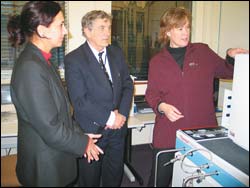New instrument makes UCT a national resource
18 October 2004
New purchase: Prof Judith Sealy, head of archaeology, right, explains how the mass spectrometer works. With her are Prof Luigi Nassimbeni, of the university's equipment and research committees, and deputy vice-chancellor Prof Cheryl de la Rey.
National and international researchers are set to benefit from a new light stable isotope mass spectrometer, thanks to a substantial grant from the Andrew W Mellon Foundation.
The new piece of equipment (which cost over R3-million) will allow researchers from UCT's departments of archaeology, botany, oceanography and the Quaternary Research Centre within the science faculty to maintain their international standing and develop innovative applications for the technology.
As the only research and teaching stable light isotope laboratory in the country, UCT's facility is a national resource. Since 1994, the old instrument allowed more than 100 researchers to analyse well over 100 000 samples.
Besides university users, researchers have come from other institutions, including all the major universities in South Africa, agricultural, wildlife and forestry institutes and universities in the United Kingdom, the Unites States, Norway, Sweden and several African countries.
In high demand, the previous instrument was booked for at least four months in advance, and two serious breakdowns in the last six months caused disruptions of research schedules.
Funding for the new equipment also came from the HTH Wills Charitable Trust and the UCT equipment committee.
 This work is licensed under a Creative Commons Attribution-NoDerivatives 4.0 International License.
This work is licensed under a Creative Commons Attribution-NoDerivatives 4.0 International License.
Please view the republishing articles page for more information.










